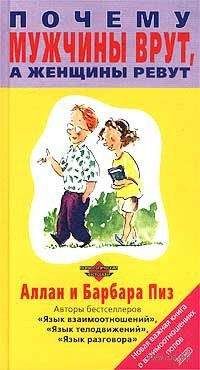Брюс Худ - Иллюзия «Я», или Игры, в которые играет с нами мозг
155
D.T. Neal and T.L. Chartrand, «Embodied emotion perception: Amplifying and dampening facial feedback modulates emotion perception accuracy», Social Psychological and Personality Science (2011): doi: 10.1177/ 1948550611406138.
156
«Бешеный бык» (англ. «Raging Bull») – художественный фильм режиссера Мартина Скорсезе, вышедший на экраны в 1980 году. Снят по мотивам мемуаров известного американского боксера, чемпиона мира среди профессионалов Джейка Ламотты. – Примеч. пер.
157
S.-J. Blakemore, D. Bristow, G. Bird, C. Frith and J. Ward, «Somatosensory activations during the observation of touch and a case of vision-touch synaesthesia», Brain, 128 (2005), 1571–83.
158
J. Ward, The Frog Who Croaked Blue: Synesthesia and the Mixing of the Senses London: Routledge (2008).
159
M.J. Richardson, K.L. Marsh, R.W. Isenhower, J.R.L. Goodman and R.C. Schmidt, «Rocking together: Dynamics of intentional and un‑ intentional interpersonal coordination», Human Movement Science, 26 (2007), 867–91.
160
M.S. Helt, I.-M. Eigsti, P.J. Snyder and D.A. Fein, «Contagious yawning in autistic and typical development», Child Development, 81 (2010), 1620–31.
161
Англ. «Stand by Me» – драма 1986 года, снятая Робом Райнером по повести Стивена Кинга «Тело». Мальчики отправляются на поиски тела погибшего ребенка. Горди – один из этой компании. – Примеч. пер.
162
T.J. Cox, «Scraping sounds and disgusting noises», Applied Acoustics, 69 (2008), 1195–1204.
163
O. Sacks, The Man Who Mistook His Wife for a Hat (New York, NY: Harper Perennial, 1987), 123.
164
Примерно к 25 годам. – Примеч. ред.
165
В этом контексте тиком называют любое повторяющееся неконтролируемое движение или поведение. – Примеч. ред.
166
На русском языке вышел под названием «Образцовый самец». – Примеч. пер.
167
C.H. Cooley, Human Nature and the Social Order (New York, NY: Scribner's, 1902).
168
N. Breen, D. Caine and M. Coltheart, «Mirrored-self misidentification: Two cases of focal onset dementia», Neurocase, 7 (2001), 239–54.
169
J. Cotard, Etudes sur les Maladies Cerebrales et Mentales (Paris: Bailliere, 1891).
170
E.C.M. Hunter, M. Sierra and A.S. David, «The epidemiology of depersonalisation and derealisation: A systematic review, Social Psychiatry Psychiatric Epidemiology, 39 (2004), 9–18.
171
A.J. Barnier, R.E. Cox, M. Connors, R. Langdon and M. Coltheart, «A stranger in the looking glass: Developing and challenging a hypnotic mirrored-self misidentification delusion», International Journal of Clinical and Experimental Hypnosis, 59 (2011), 1–26.
172
G.B. Caputo, «Strange-face-in-the-mirror illusion», Perception, 39 (2010), 1007–8.
173
G.G. Gallup, «Chimpanzees: Self-recognition», Science, 167 (1970), 86–7.
174
B.I. Bertenthal and K.W. Fischer, «Development of self-recognition in the infant», Developmental Psychology, 14 (1978), 44–50.
175
P. Rochat, Others in Mind: Social Origins of Self-Consciousness (Cambridge: Cambridge University Press, 2009).
176
D. Bruce, A. Dolan and K. Phillips-Grant, «On the transition from childhood amnesia to the recall of personal memories», Psychological Science, 11 (2000), 360–64.
177
M.J. Eacott, «Memory for the events of early childhood», Current Directions in Psychological Sciences, 8 (1999), 46–9.
178
Название книги можно перевести как «Вечное сегодня». – Примеч. пер.
179
D. Wearing, Forever Today: A Memoir of Love and Amnesia (London: Doubleday, 2005).
180
Wearing (2005), 158.
181
J. Piaget, The Child's Construction of Reality (London: Routledge and Kegan Paul, 1955).
182
C. Rovee and D.T. Rovee, «Conjugate reinforcement of infant exploratory behavior», Journal of Experimental Child Psychology, 8 (1969), 33–9.
183
D.B. Mitchell, «Nonconscious priming after 17 years: Invulnerable implicit memory?», Psychological Science, 17 (2006), 925–9.
184
E. Tulving, Elements of Episodic Memory (Oxford: Clarendon Press, 1983).
185
M.A. Conway and C.W. Pleydell-Pearce, «The construction of autobiographical memories in the self-memory system», Psychological Review, 107 (2000), 261–88.
186
H.L. Roediger III and K.B. McDermott, «Tricks of memory», Current Directions in Psychological Science, 9 (2000), 123–7.
187
F.C. Bartlett, Remembering (Cambridge, England: Cambridge University Press, 1932).
188
E.F. Loftus, «Leading questions and eyewitness report», Cognitive Psychology, 7 (1975), 560–72.
189
E.F. Loftus, «Lost in the mall: Misrepresentations and misunderstandings», Ethics and Behaviour, 9 (1999), 51–60.
190
Историю ложных воспоминаний Пиаже можно найти в: C. Tavris, «Hysteria and the incest-survivor machine», Sacramento Bee, Forum section (17 January 1993).
191
K.A. Wade, M. Garry, J.D. Read and D.S. Lindsay, «A picture is worth a thousand lies: Using false photographs to create false childhood memories», Psychonomic Bulletin and Review, 9 (2002), 597–603.
192
Воспоминания Лофтус об этом инциденте взяты из J. Neimark, «The diva of disclosure, memory researcher Elizabeth Loftus», Psychology Today, 29 (1996), 48.
193
D.J. Simons and C.F. Chabris, «What people believe about how memory works: A representative survey of the US population», PLoS ONE, 6:8 (2011): e22757, doi:10.1371/journal.pone.0022757.
194
W.L. Randall, «From compost to computer: Rethinking our metaphors for memory», Theory Psychology, 17 (2007), 611–33.
195
Simons, quoted in K. Harmon, «4 things most people get wrong about memory», Scientific American (4 August 2011), http://blogs.scientificamerican.com/observations/2011/08/04/4-things-most-people-get-wrong-aboutmemory.
196
Оригинальное название «We can remember it for you for whole sale» буквально можно перевести «Мы можем помнить для вас все оптом». – Примеч. пер.
197
P.K. Dick, «We can remember it for you wholesale», Magazine of Fantasy and Science Fiction (April 1966).
198
Total Recall (1990), directed by Paul Verhoeven.
199
K. Tustin and H. Hayne, «Defining the boundary: Age-related changes in childhood amnesia», Developmental Psychology, 46 (2010), 1049–61.
200
M.L. Howe and M.L. Courage, «On resolving the enigma of infantile amnesia», Psychological Bulletin, 113 (1993), 305–326.
201
Rochat (2009).
202
D. Premack and G. Woodruff, «Does the chimpanzee have a theory of mind?», Behavioral and Brain Sciences, 1 (1978), 515–26.
203
История Бинти рассказана в: S. Budiansky, «Still red tooth and claw», Wall Street Journal (12 March 1978).
204
Исследования, касающиеся отслеживания младенцами взгляда, указывают на то, что этот навык проявляется очень рано и может быть даже врожденным. См., например: B.M. Hood, J.D. Willen and J. Driver, «An eye direction detector triggers shifts of visual attention in human infants», Psychological Science, 9 (1998), 53–6.
205
A. Phillips, H.M. Wellman and E.S. Spelke, «Infants» ability to connect gaze and emotional expression to intentional action», Cognition, 85 (2002), 53–78.
206
B.M. Repacholi and A. Gopnik, «Early reasoning about desires: Evidence from 14– and 18-month-olds», Developmental Psychology, 33 (1997), 12–21.
207
D.J. Povinelli and T.J. Eddy, What Chimpanzees Know about Seeing, Monographs of the Society of Research in Child Development 61:2:247 (Boston, MA: Blackwell, 1996).
208
D. Dennett, «Beliefs about beliefs», Behavioral and Brain Sciences, 1 (1978), 568–70.
209
A. Gopnik and J.W. Astington, «Children's understanding of representational change and its relation to the understanding of false belief and the appearance reality distinction», Child Development, 59 (1988), 26–37.
210
H. Wimmer and J. Perner, «Beliefs about beliefs: Representations and constraining function of wrong beliefs in young children's understanding of deception», Cognition, 13 (1983), 103–128.
211
A. Gopnik (2009) The Philosophical Baby; What Children's Minds Tell us About Truth, Love, and the Meaning of Life. Farrar, Straw & Gironx, NY.
212
A. McAlister and C. Peterson, «A longitudinal study of child siblings and theory of mind development», Cognitive Development, 22 (2007), 258–70.
213
Название можно перевести как «Сопереживающий мозг». – Примеч. пер.
214
C. Keysers, The Empathic Brain (Los Gatos, CA: Smashwords e-book, 2011).
215
C.J. Newschaffer, L.A. Croen and J. Daniels et al., «The epidemiology of autism spectrum disorders», Annual Review of Public Health, 28 (2007), 235–58.
216
U. Frith, Autism: Explaining the Enigma (2nd ed., Oxford: Wiley-Blackwell, 2003).
217
Это наиболее адекватный перевод принятого на Западе (и использованного здесь в оригинале) понятия «Mindblindness», которое часто переводят как «слепота разума», что делает его смысл совершенно непонятным. Mindblindness подразумевает отсутствие должной психологической проницательности для понимания внутреннего мира другого человека. – Примеч. ред.
218




